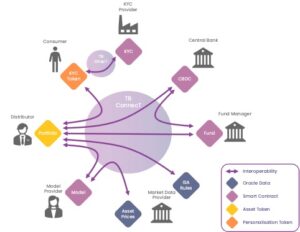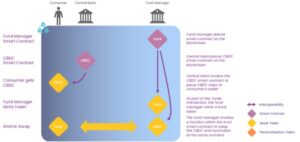In the context of blockchain, interoperability refers to the capabilities for tokenised assets and other tokens to interact with each other to deliver a business process.
Predominantly, this is achieved through the use of smart contracts. With so many blockchain networks, cross-chain interoperability (the interaction of smart contracts and tokenised assets in different networks) becomes critical. Collectively, with greater adoption of tokenised assets and personalisation tokens comes a network effect of greater benefit for all parties.
Interoperability using smart contracts
Interoperability is usually taken to mean operations across chains, but it really starts with how individual smart contracts and tokens interoperate.
At Tokenbridge, we’re committed to enabling interoperability between tokens regardless of their location or network.
To illustrate how smart contracts enable interoperability (even on the same blockchain network), let’s look at the example of an atomic swap: the exchange of one tokenised asset for another – in this case a CBDC [Central Bank Digital Currency] for a tokenised fund.
The logic for the minting of the CBDC, the minting of the fund token and the atomic swap are all coded into the relevant smart contracts.
Cross-chain interoperability
Things get more complicated as soon as more than one blockchain network is involved.
A blockchain network can only rely on data that is within its own boundaries (see the Tokenbrief on oracles for an explanation of determinism). So even though the data is on a blockchain network somewhere, the local network cannot trust it.
There are different strategies to address this cross-chain interoperability.
One potential strategy is to make every token (asset and/or personalisation) available on every blockchain network. However, with the potential for new networks all the time, and with some banking networks being private, it seems that this approach is unlikely to succeed.
A second approach is for the blockchain community to devise and agree a protocol for cross-chain interoperability, such as the CCIP [Cross-Chain Interoperability Protocol] proposed by Chainlink. Still experimental, this approach could take one of two forms.
The first is referred to as “asset transformation” (also known as asset bridging) where the tokenised asset moves from one blockchain to another, either as a “wrapped asset” (where the underlying assets are locked on the source chain and minted as wrapped assets on the destination chain) or as “native assets” (where the assets are burned on the source chain and minted as native, non-wrapped assets on the destination chain).
These mechanisms are also referred to as “lock-and-mint” or “burn-and-mint”.
The second is to use cross-chain messaging, where the assets remain on the source chain and messages are sent between the source and a destination chain.
In fact, the Chainlink CCIP uses elements of all of these approaches.
The Tokenbridge approach to cross-chain interoperability is similar to the messaging option, except that TBConnecT acts as the layer between the two networks.
In this approach, TBConnecT acts as the “glue” between the blockchains. This follows our mantra that “we connect to the blockchain so [you] don’t have to.” We take on the pain of connecting to the relevant networks and manage the interoperability between them.
Naturally, this does not preclude the use of an agreed protocol should it become industry standard and can be proven to be reliable and secure.
Network effect
The more tokens exist and are in use (especially personalisation tokens such as KYC and model portfolios), the more interoperability there will be, leading to a virtuous circle network effect.
The role of Tokenbridge
Tokenbridge software exists to provide this interoperability between tokens on one network or across multiple networks.
For example, in the process of buying a mutual fund on-chain, TBConnecT might need to create links between the fund smart contract, a CBDC (Central Bank Digital Currency) smart contract, and the consumer’s KYC token.